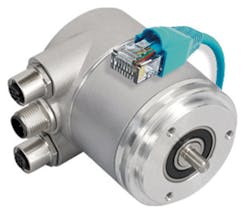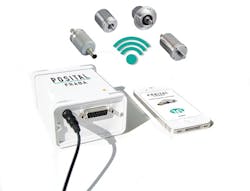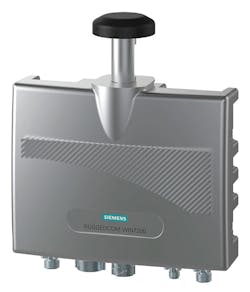Choosing the Right Devices for IoT Connected Systems
This file type includes high-resolution graphics and schematics when applicable.
The Internet of Things (IoT) is bringing the power of connected systems to engineering. This wave of technology is powering future devices to have the latest and multiple connection points. Many products are using the power of Ethernet to enable their connections as it becomes the main method of communication between devices. Companies are also introducing faster and more powerful wireless connections. This will provide mobile and remote access to systems. Being able to harness plant systems via smartphones and tablets will offer manufacturers a new level of productivity.
RUGGEDCOM RSG920P
The RUGGEDCOM RSG920P is a small form-factor Layer 2 switch from Siemens. The networking switch connects devices together, sending and receiving data only to connected devices that require the data. The switch has a rugged design and Power-over-Ethernet (PoE) capability. The device can handle various PoE devices like cameras, intercom devices, Wireless LAN Access Points, and Bluetooth sensors.
The design of the switch is compact for space-limited cabinets. The RSG920P has high bandwidth capabilities and has 20-Gb ports including four Small-Form-Factor Pluggable (SFP) Gigabit/Fast Ethernet slots and four PoE ports supporting 802.3af / 802.3at with up 30 W/port. The switch is built to handle extreme temperature (–40 to 85°C), vibration (IEC 60255-21-1, Class 2), humidity (IEC 60068-2-30, up to 95% relative humidity), and shock conditions (IEC 60255-21-2, Class 2) found in industrial applications such as transportation and oil/gas systems.
The RSG920P also has several security features set in place at the local-area-network level, including:
• Passwords: Support for separate credentials multiple access levels.
• SSH/SSL: Extends capability of encryption of passwords and data.
• Enable/disable ports: Capability to disable ports to disable unauthorized connected devices.
• SNMPv3: Encrypted authentication and access security.
• HTTPS: Secure access to the Web interface.
• 802.1x: Ensures only permitted devices can connect to the device.
• MAC address authentication: Control access to devices that do not support the operating system
Bosch Rexroth IAC-Multi-Ethernet
Ethernet connections are becoming the standard in automation and are leading the way in IoT connected systems. Ethernet has 10 to 100 times higher data throughput rates than with fieldbuses, is a widespread technology, cost-comparable to analog interfaces, based on industry standards, and is flexible and compatible with current automation systems. As industrial Ethernet is becoming the standard for automation connections, devices like the IAC-Multi-Ethernet axis controller allow for multiple Ethernet connections.
The IAC-Multi-Ethernet axis controller is used on hydraulic systems, providing direct control on high-response valves used in servos. The 4WRPDH valve used with the controller is available in a size 6 or 10, has a max operating pressure of 315 bar, maximum volume flow of 100 l/min, two configurable analog sensors for current and voltage, one linear position measuring system, and integrated digital axis-control functionality. The way this axis controller is enabling higher-level control network connections is that it functions on multiple levels of Ethernet connectivity. It can connect via sercos, EtherCAT, EtherNET/IP, or PROFINET RT. This allows for the control architecture to remain intact. The control axis is independent of the machine control by using a separate motion function and data processing of sensors via direct sensor connections.
Posital Absolute Rotary Encoders
The encoders by Posital are also designed to keep up with IoT world. Posital offers absolute rotary encoders that rotate precisely without losing track of their position even if power is lost. Absolute rotary encoders provide unique position values by detecting the position of a coded element with each position corresponding to a unique code. Single-turn encoders offer 360 deg. of rotation measurement range in one turn while multi-turn encoders provide a measurement range greater than 360 deg. by measuring the number of revolutions. They have a resolution of up to 16 bits.
The encoders can connect to networks in many different ways. The new standard of Ethernet is possible via EtherCAT, Ethernet/IP, ProfiNet, and Modbus+Ethernet TCP. The encoders are also available with analog, CANopen, Profibus, DeviceNet, J1939, Interbus, Powerlink, and SSI connections. The absolute encoders have a protection class up to IP69K for stainless steel and are ATEX-certified for safety in explosive environments. The encoders are programmable via the wireless hub designed by Posital allowing portable devices interfaces. They can be used in medical equipment, factory automation, oil, gas, and renewable energy industries.
Posital Programmable Encoder 2.0
Wireless connections are playing a major part in automation facilities. As more machines get connected to network systems, devices will become more wireless. The Programmable Encoder 2.0 from Posital provides new capabilities to program its series of IXARC rotary encoders. The encoders can be programmed via any device connected to the network whether it is a laptop, tablet, or smartphone.
Measurement characteristics that can be modified via the application include five different rotation measurement modes (incremental, SSI single-turn, SSI multi-turn, SSI single-turn + incremental, and multi-turn + incremental) and absolute encoder parameters (single-turn resolution, multi-turn range, code gray, code binary, and clockwise or counterclockwise code sequence). The adjust range of the resolution of the incremental encoder signals is 1 to 16384 PPR.
The UBIFAST Configuration tool is needed to configure the encoders wirelessly. The UBIFAST is connected to the encoders and then establishes its own hotspot. Then any laptop or portable device can log on to the Wi-Fi transmitted by the UBIFAST and have access to the encoders’ programming settings. This is done through the Web browser; no app or software is required. Posital offers more than 2,900 encoders that can be programmed using UBIFAST.
RUGGEDCOM WIN7200
Siemens offers the ability to make connected devices mobile by connecting the WIN7200. The WIN7200 is a lightweight, broadband wireless base station. The device complies with the IEEE 802.16e standard and is designed for use in unlicensed or lightly licensed frequency bands operating in harsh environments. The wireless base is a single-sector lightweight station so that it can be easily installed on poles or walls. A single PoE connection is enough to power and connect the device reducing cost and complexity. It is powered by OFDMA radio technology that enables Non-Line-Of-Sight operation.
The device is designed for harsh environments meeting the IEEE 1613, IEC 61850-3, Class 1 Div 2/ATEX Zone 2 requirements, as well as the MIL-STD 810F, MIL-STD 509.4 requirements for salt fog. The robust hardware has temperature limits of –40 to 75°C. The WIN7200 supports the following WiMAX connections at 2.5-, 3.5-, 3.65-, 4.9-, and 5.8-GHz bands. The device is also Mobile WIMAX-compliant based on IEEE 802.16e standard and WIMAX Forum Wave 2 profiles.
Motorola WAVE 5000
The advantage of an established IoT network is advanced communication. Ethernet provides the ability for these systems to be connected to the Internet. Users with mobile devices or who are remote can receive information about their systems that before would have required on-site access. Motorola's WAVE 5000 updates push-to-talk (PTT) technology by providing different apps and Web clients connecting portable devices and computer systems to PTT networks. Any smartphone or computer can be used as a PTT device simply by installing an application.
By using WAVE 5000 in conjunction with WAVE Connections, a cloud-based PTT, factory plants can notify users remotely. Essentially, if you have an automation line and the sensors are tripped causing a production stop or failure, the alarm is pushed through the connected network and uses the cloud PTT to alert the end user via their mobile device. The connection is fully secure with AES 256 bit encryption and is scalable for up to 2,000 users.
Wittenstein Online Service Portal
The access to the Internet adds the benefit of resources. The ability to obtain information quickly is a pillar of Internet access. Wittenstein, a motion-control company that produces gearboxes, motors, actuators, and rack and pinion systems, recently introduced its Online Service Portal. The parts will have a QR code as part of the label.
This QR can be scanned by any QR code app on a smartphone or tablet. The QR code, once scanned, will provide the user access to all the relevant information of that part via the online portal. The Online Service Portal contains installation information, reference documentation, maintenance documents, and diagnostic services for their parts. Besides being on the part label, a QR sticker can be placed on the machine, cabinet, desk, or any other location so that the code can be quickly scanned.








